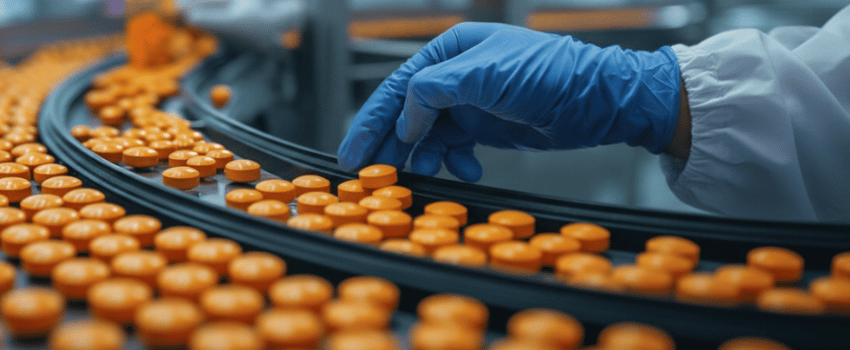
Nitazenes and cathinones are two fast-emerging New Psychoactive Substances (NPS) whose potency, increasing availability, and shape-shifting properties are a significant challenge for analytical scientists, researchers, and regulators alike. In this article, we discuss the development of both cathinones and nitazenes and the dangers they pose, as well as their rapid emergence as popular street drugs. We also consider some of the technical issues facing researchers and forensic and toxicology testing laboratories as they work to characterise and understand these highly heterogeneous and dangerous substances.
What are nitazenes?
Nitazenes are powerful synthetic opioids also known as benzimidazole opioids, or 2-benzyl-benzimidazole opioids, after their characteristic structural core. They were initially developed as analgesics by the Swiss pharmaceutical company CIBA between the 1950s and 1970s, but their significant drawbacks – including severe respiratory depression and addictive potential – meant the programme was abandoned. As street drugs, nitazenes are sold as a powder or crystalline solid, and have also been found mixed into tablets, heroin, ketamine, and synthetic cannabinoids. Nitazenes can be injected, inhaled or swallowed and, like many opioids, they induce euphoria and relaxation as well as relieve pain. But they can also cause nausea, slow breathing, and a lowered heart rate. However, the major problem with nitazenes is their potency – with animal studies demonstrating that compounds like isotonitazene and N-pyrrolidino etonitazene exhibit “higher pharmacological activity than fentanyl, and several orders of magnitude higher than morphine.” This means that, compared to consuming “traditional” opioids, taking nitazenes greatly increases the likelihood of overdose and death.
What are cathinones?
Synthetic cathinones are central nervous system stimulants that are chemically related to S(−) Cathinone - an enantiomeric compound found in the leaves of the khat plant, Catha edulis - and are also similar in structure to amphetamine and methamphetamine. First synthesised in the 1920s, various cathinones have been used as medicines around the world, although some were later withdrawn or banned because of concerns about misuse, including intravenous use.
In the early 2000s, uncontrolled synthetic cathinones like methylone, mephedrone, and MDPV were openly sold on the internet and in retail outlets as “legal highs”, before the introduction of generic (structure based) controls in various countries. Today, as then, cathinone drugs are known colloquially as “bath salts”, “plant food”, or “research chemicals”, and sold in powder, crystal, tablet, or vape form. They can be snorted or “keyed,” ingested orally, injected, and smoked – with negative effects including nose bleeds, confusion, and anxiety, as well as fatal hyperthermia, strokes, and heart attacks. According to the European Union Drug Agency (EUDA), the health risks of synthetic cathinones may be more severe than those of other structurally similar stimulants because of their higher potency – especially in the case of pyrrolidino derivative analogues, like α-PHiP. In addition, cathinones can increase the likelihood of risky sexual behaviours, sharing of injecting material, and HIV transmission among users.
“Like a tsunami” – the escalation of the global nitazenes threat
As one study of nitazenes points out, “fentanyl analogues dominated ... opioid markets prior to 2019,” only for production and supply to be largely halted by class-wide bans in both the United States (US) and China. “In the wake of these bans” the study adds, “the recreational drug market has adapted accordingly with a subsequent shift towards non-fentanyl opioids” – with nitazenes emerging to claim fentanyl’s former crown. Another report agrees that “It was not until 2019 that nitazenes gained widespread recognition,” with isotonitazene first detected in Canada and Europe in March of that year, “followed by the successive emergence of other structural analogues such as metonitazene, butonitazene and etodesnitazene.” In January 2021, N-pyrrolidino etonitazene was observed in only four forensics cases sent to the US analytical testing firm NMS Labs, but by November that year the monthly figure had increased 12-fold, to 48. Despite such a fast start, the availability of nitazene drugs is still growing today – with the quantity of nitazene powders detected in Europe tripling between 2022 and 2023. During 2023, European countries confiscated almost 24,000 nitazene-containing tablets, compared to just 430 in 2022, while preliminary data for 2024 indicates that more than 50,000 nitazene tablets may have been seized. Around the globe, according to the United Nations Office on Drugs and Crime’s World Drug Report 2024, “The number of new unique nitazenes… is now approaching the number of fentanyl analogues not under international control.”
The escalation in nitazene supply is not the only bad news for users, however. Nitazenes are increasingly being sold mixed with other drugs including heroin and xylazine and, even more worryingly, in fake prescription medicines containing counterfeit oxycodone and benzodiazepines. This raises concerns that nitazene use might “spread beyond high-risk opioid users to broader populations without opioid tolerance, including young people.” The sheer unpredictability of nitazene street drugs is already taking a heavy toll on peoples’ lives, however, with Ireland reporting around 20 non-fatal overdose cases linked to counterfeit benzodiazepine tablets containing protonitazene in June 2024. Nitazene opioids – such as isotonitazene, protonitazene and metonitazene - were also linked to over half of the 273 drug-induced deaths in Estonia and Latvia in 2023, as well as 176 fatalities in the UK. Meanwhile “significant numbers of overdoses linked to etonitazepyne have been reported in the United States and, to a lesser extent, in Canada.”
Drug support workers in Scotland say the near-invisible penetration of nitazenes into the street drugs market means users are “‘playing Russian roulette’ because they have no idea whether nitazene has been used by their dealers.” And, perhaps unsurprisingly, authorities trying to stem the nitazene tide are highly concerned about the potential for an even worse crisis. EUDA says that “While the number of seizures remains relatively small, these data may suggest potential market expansion for these life-threatening substances.” The Director of the UK National Crime Agency, Graham Biggar, goes further, warning that “It (nitazene supply) has the real potential to escalate and became the major cause of deaths.” And Kevin Neary, co-founder of Scottish drug charity Aid and Abet, told the BBC “There's a massive danger it'll come like a tsunami.”
The growing cathinones threat
Cathinones are beginning to disrupt the stimulants market in a similar manner to nitazenes, and challenging established drugs for primacy on the streets. The World Drug Report states that in Central Asia, Transcaucasia and Eastern Europe, “the past decade has seen a gradual shift (from)… opiates… towards the use of synthetic stimulants, notably cathinones.” In Europe, EUDA adds that “amphetamine use has always been the most common (but) recently, a shift appears to have taken place, with synthetic cathinones… increasingly available (and) unprecedented seizures and imports taking place.” Between 2021 and 2023, European seizures of cathinones rose from 4.5 tonnes to 37 tonnes – a significant number of them arriving from India. However, many were also confiscated from “large-scale laboratories” in Poland – where 53 cathinone labs were discovered - the Netherlands, Belgium, and Germany. The fact that cathinones can be produced “relatively easily” from as-yet unscheduled precursor chemicals, says EUDA, “may have facilitated their production in the European Union,” and may have also driven a near-400% increase in EU residents seeking treatment for problems related to cathinones between 2018 and 2023. In 2023, the deaths of 39 Europeans were reported as involving cathinones, although this number is “a minimum estimate” since cathinones are not yet systematically searched for post-mortem in every country.
Challenges in nitazene and cathinone testing and research
The rapid growth in nitazene and cathinone supply, and the severe health risks inherent in consuming both drugs, have led to agreement that meaningful scientific and regulatory responses are urgently needed. “With potent new synthetic opioids such as nitazenes available in the European Union and creating serious health risks,” says EUDA, “it is essential to improve Europe’s ability to identify new substances, determine the purity of drugs and conduct pharmacological profiling to clarify what substances are being sold.” Likewise, it states that “increased cathinone consumption highlights the role of forensic and toxicological analysis for understanding consumption trends and the scale and nature of any associated adverse health outcomes.”
But because neither cathinones nor nitazenes have been extensively researched to date, getting up to speed will not be easy. For example, there is an acceptance that existing methods for identifying illicit stimulant drugs like amphetamines are not suitable for more heterogeneous cathinone compounds. Similarly, EUDA admits that “Due to their high potency and novelty, there are concerns that nitazene opioids may not be routinely detected in procedures commonly used for post-mortem toxicology, resulting in underestimates of their involvement.”
Perhaps the biggest challenge in devising better models for identifying, characterising, tracking, and scheduling cathinones and nitazenes - as well as understanding their mechanisms of action and devising effective ways of treating overdoses – is the sheer number of different compounds that could yet appear on the market. As one research report on nitazenes puts it, “Due to the ease of modification of its parent nucleus, abusers and dealers can rapidly synthesize new structural analogs that fall outside the drug control catalog. Consequently, multiple isomers of nitazenes have emerged, causing significant interference in forensic practices.” Another report, this time on cathinones, makes a near-identical point, stating: “these agents do not represent a pharmacologically (i.e., behavioral) or mechanistically homogeneous class of agents.” Therefore, “the available agents might represent only the ‘tip of the iceberg’ (and) the potential for many more new synthetic cathinones is very real. Investigation of these… on an agent-by-agent basis is a daunting task.”
|
LGC Standards – supporting better nitazene and cathinone testing and research
LGC Standards reference materials and research chemicals are critical tools for applying science to some of the world’s most urgent and complex problems.
We have therefore developed an extensive range of forensic science and toxicology products to support testing laboratories and researchers in responding to the fast-emerging threat of New Psychoactive Substances (NPS), including 800+ nitazenes and cathinones.
Our standards can play critical roles in understanding nitazene and cathinone pharmacology and toxicity, in supporting their accurate identification and quantification during casework, and in developing improved methods of analysis.
Featuring more than 700 products from our in-house TRC, Logical, and Lipomed ranges and leading third-party suppliers, our cathinone portfolio boasts 120+ ISO-17034 accredited standards that give you additional confidence in the quality of your results. It also includes many frequently encountered cathinone compounds - such as mephedrone, α-PHP, α-PHiP, dibutylone, and MDPHP.
Our range of nitazene reference standards and research chemicals meanwhile features more than 100 products, including commonly tested for compounds like isotonitazene, metonitazene, and etonitazene.
LGC Standards’ custom synthesis capabilities can also deliver you tailored standards to help accurately identify and quantify emerging cathinones and nitazenes – allowing you to pivot quickly to new drug threats and boost the productivity and profitability of your lab.
|



